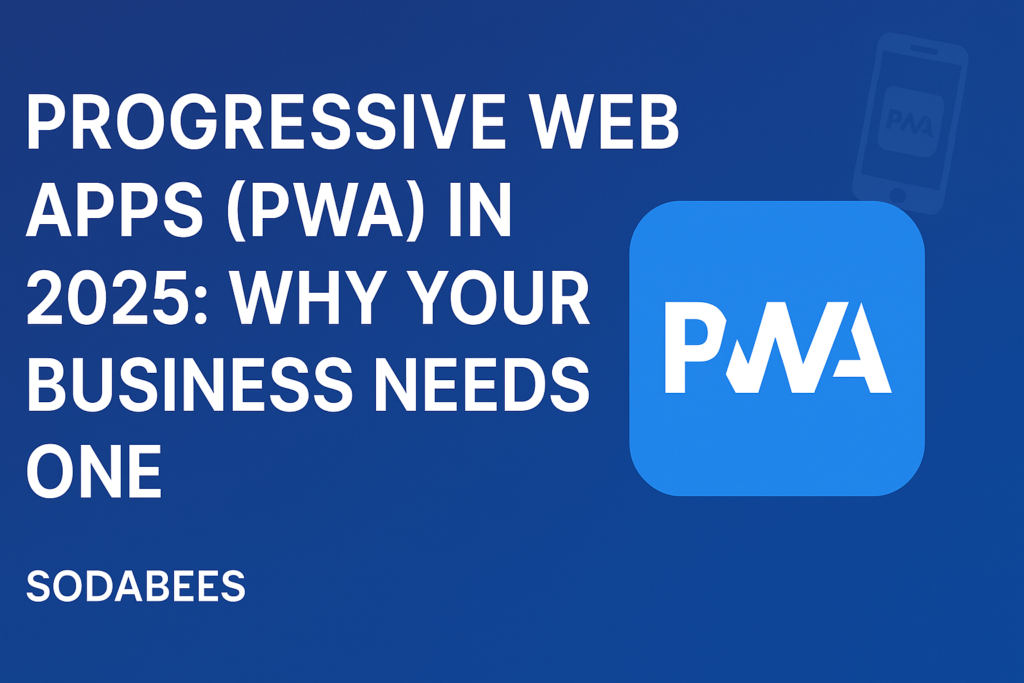In 2025, the line between websites and mobile apps is thinner than ever. Customers expect speed, reliability, and an app-like experience no matter which device they’re on. Progressive Web Apps (PWAs) deliver exactly that — combining the discoverability of websites with the engagement power of apps. Whether you’re a startup or an enterprise, PWAs can save costs, increase user retention, and help you scale faster than traditional native apps.
What Is a Progressive Web App?
A Progressive Web App is essentially a website built with advanced web technologies that make it feel and behave like a native app. PWAs can:
-
Load instantly, even on slow networks
-
Work offline using service workers
-
Send push notifications directly to users
-
Be “installed” on a phone’s home screen without the App Store
Think of it as a single codebase that runs seamlessly on desktop, mobile browsers, and as an app-like icon on mobile devices.
Examples of PWAs you already use:
-
Twitter Lite – a lightweight version of Twitter that’s fast even on 2G
-
Starbucks PWA – lets customers browse, customize, and order offline
-
Pinterest – improved engagement and time-on-site after moving to a PWA
Why PWAs Matter for Businesses in 2025
PWAs are no longer experimental. Google, Microsoft, and Apple now support core PWA features in their browsers. Businesses adopting PWAs see:
-
Faster load times → lower bounce rates
-
Higher conversions → app-like UX without app-store hurdles
-
Reduced development cost → one build for all devices
-
Offline availability → better reliability in emerging markets
Stat check: In 2025, businesses running PWAs report up to 68% higher mobile engagement and 3x better conversion rates compared to mobile websites.
Website vs PWA: The Key Difference
| Feature | Traditional Website | Progressive Web App |
|---|---|---|
| Speed | Good | Excellent |
| Offline Use | Limited | Yes (Service Worker) |
| Push Notifications | No | Yes |
| Home-Screen Install | No | Yes |
| App Store Listing | No | Optional |
| Development Cost | Lower | Moderate but cheaper than native apps |
Another way to put it:
-
Websites tell users information.
-
PWAs let users do things, faster and with an app-like feel.
Native App vs PWA: Cost and Time
-
Native apps need separate builds for iOS and Android. This doubles development and maintenance costs.
-
PWAs use one codebase, reducing build time by up to 50% and ongoing maintenance by up to 70%.
For startups or SMEs, this is a big cost-saver.
User Experience Advantages
-
No downloads: Users open a link; add to home screen in seconds.
-
Auto updates: No app-store approvals; new features go live instantly.
-
Lightweight: PWAs often take <1MB storage vs 20–200MB for native apps.
SEO & Discoverability
Because PWAs are still websites under the hood, they’re fully indexable by search engines. This means:
-
Higher discoverability vs native apps
-
Ability to leverage your existing SEO strategy
-
Faster sharing and linking (no app-store barrier)
When Does a Business Need a PWA?
Ask yourself:
-
Do my users need to interact with my platform frequently?
-
Are my customers on low-connectivity networks?
-
Do I want to reduce app-store dependency and cost?
If yes to any of these, a PWA could be your best move.
Progressive Web App Examples by Industry
-
E-commerce: Flipkart Lite, AliExpress PWA
-
Food & Beverage: Starbucks, Trivago
-
Media: Forbes PWA loads in 0.8 seconds
-
SaaS: Trello’s web version runs as a PWA
These companies saw measurable lifts in retention, conversion, and engagement after adopting PWAs.
PWA Development: What Skills Are Needed
Building a PWA isn’t like creating a simple static site. It requires:
-
Front-end frameworks: React, Angular, Vue
-
Service workers & caching: For offline capabilities
-
Push notifications API
-
Responsive UI/UX design
At Sodabees, our developers specialize in these technologies to deliver robust, scalable PWAs for clients worldwide.
Why Choose Sodabees for Your PWA Project
Sodabees offers full-stack development services covering:
-
Custom PWA Strategy & Design
-
Cross-Platform App Development (iOS, Android, Web)
-
AI-powered Features for Personalization
-
Secure Payment Integrations
-
Ongoing Maintenance and Support
We don’t just build; we consult, plan, and deliver measurable business results.
Cost of Building a PWA in 2025
While costs vary by features and complexity, here’s a ballpark:
-
Basic PWA: $5,000 – $15,000
-
Mid-Level (e-commerce): $15,000 – $40,000
-
Enterprise-Grade: $40,000+
This is still significantly lower than building and maintaining separate native apps.
The Future of PWAs
In 2025 and beyond, expect:
-
Deeper OS integration (push, file system access)
-
More app-store support (Microsoft Store already lists PWAs)
-
Wider browser adoption (Safari now supports core features)
PWAs are moving from “nice to have” to “must have” for businesses.
Quick Checklist: Do You Need a PWA?
-
Want an app-like experience without app stores?
-
Need offline support?
-
Targeting cost-effective cross-platform reach?
If you tick at least two, you’re ready for a PWA.
FAQs: Progressive Web Apps
1. What is a Progressive Web App (PWA)?
A PWA is a website that behaves like a native app, offering offline access, push notifications, and home-screen installation.
2. How is a PWA different from a website?
A PWA adds app-like features such as offline use, notifications, and faster performance compared to a regular website.
3. Is a PWA cheaper than a native app?
Yes. PWAs typically cost 30–70% less to build and maintain because you only need one codebase.
4. Can a PWA be added to app stores?
Yes. Microsoft Store and Google Play allow PWAs. Apple is expanding support gradually.
5. Does a PWA work on iOS?
Yes. Modern versions of iOS support core PWA features like offline caching and home-screen installation.
6. How long does it take to build a PWA?
Depending on complexity, 4–12 weeks for basic to mid-level PWAs; enterprise-grade can take longer.
7. Will a PWA improve SEO?
Yes. Because PWAs are indexable web assets, they can improve visibility in search results compared to hidden native apps.


